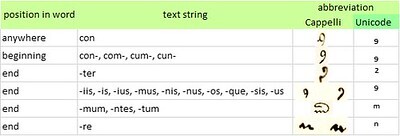Voynich Reconsidered: Latin as precursor
In Voynich Reconsidered (Schiffer Publishing, 2024), I devoted a chapter to the proposition that one of the precursor languages of the Voynich manuscript might have been Latin. I titled the chapter “Cappelli”, in homage to Adriano Cappelli, the great chronicler of abbreviations in Latin and Italian manuscripts. It seemed to me that if Latin had been a precursor, the source documents quite probably had been in a pervasively abbreviated Latin.
There were two reasons for this conjecture. One was simply that, assuming that parchment and ink were valuable commodities, it would be logical to suppose that scribes abbreviated in order to conserve materials. The second reason was more pragmatic. Latin is a language with a tendency for long words. In Dante Alighieri’s Monarchia, written between 1312 and 1313, the average length of words is 5.77 letters. By comparison, in my v101④ transliteration of the Voynich manuscript, in which I replace the v101 {4o} with the Unicode ④, the average length of a “word” is 3.78 glyphs.
So far, I have not found a machine-readable Latin text incorporating abbreviations. As an experiment, therefore, I created a version of Monarchia with abbreviations of my own devising. Drawing upon Cappelli’s work, I replaced selected text strings with Unicode symbols which resembled Cappelli’s abbreviations, as follows:

Here is an example, based on the first seven words of Monarchia:
Undoubtedly, a real scribe would have abbreviated even more rigorously. As an example: the University of Zurich has developed a wonderful crowd-sourced compilation of Cappelli's abbreviations at https://www.adfontes.uzh.ch/en/ressou.... Using this resource, I constructed a radical abbreviation of the above phrase from Monarchia, as follows:

The first seven words of Dante's "Monarchia", radically abbreviated. Image credits: Adriano Cappelli. Author's analysis.
The abbreviated phrase has 19 characters; the average word length is just 2.71 characters. We can see that Cappelli's abbreviations could easily generate a text that matched the average "word" length of the Voynich manuscript. However, this was a manual exercise; we need a mechanism for creating machine-readable renditions of abbreviated Latin texts. To this issue, I shall return.
Unabbreviated Latin
Here, I would like to back up a little, and present the results of some tests on unabbreviated Latin as a precursor language of the Voynich manuscript.
The average word length is already a downside of this hypothesis. The next test is the statistical fit between letter frequencies and glyph frequencies. Among the multiple transliterations that I had developed, I found the best fits with unabbreviated Latin as follows.
For the LatinISE medieval subcorpus, which comprises texts from the seventh to the fourteenth century, the best-fitting transliteration is:

The most common letters in the LatinISE medieval subcorpus and in Dante’s “Monarchia”; and the most common glyphs in my v103 and v171 transliterations of the Voynich manuscript. Author’s analysis.
As suitable samples of the Voynich text for mapping, I selected the most common “words” of one to four glyphs in the v103 and v171 transliterations.
To cut to the chase: the v103 transliteration yielded very few Latin words. The v171 transliteration did not work very well when mapping on the frequencies in Monarchia. However, when mapping on the frequencies in the LatinISE medieval subcorpus, v171 produced a sprinkling of common Latin words, such as “eo”, “si” and “quem”.

Test mappings from common “words” of one to four glyphs in the v171 transliteration, "herbal 1" section, to Latin as represented by the LatinISE medieval subcorpus. LatinISE count "-" means the string is not among the top 1,000 words. Author’s analysis.
Alternatives
The above results do not strongly support the hypothesis that Latin is a precursor language of the Voynich manuscript. However, they do not exclude the hypothesis. I can think of a number of alternative approaches to an extrication of Latin text from the Voynich manuscript, including the following:
There were two reasons for this conjecture. One was simply that, assuming that parchment and ink were valuable commodities, it would be logical to suppose that scribes abbreviated in order to conserve materials. The second reason was more pragmatic. Latin is a language with a tendency for long words. In Dante Alighieri’s Monarchia, written between 1312 and 1313, the average length of words is 5.77 letters. By comparison, in my v101④ transliteration of the Voynich manuscript, in which I replace the v101 {4o} with the Unicode ④, the average length of a “word” is 3.78 glyphs.
So far, I have not found a machine-readable Latin text incorporating abbreviations. As an experiment, therefore, I created a version of Monarchia with abbreviations of my own devising. Drawing upon Cappelli’s work, I replaced selected text strings with Unicode symbols which resembled Cappelli’s abbreviations, as follows:

Here is an example, based on the first seven words of Monarchia:
original: "omnium hominum quos ad amorem veritatis natura ..."My algorithmic abbreviation process reduced the average word length to 5.23 letters: still far too long, compared to the Voynich manuscript.
abbreviated: "omniᵐ hominᵐ qu⁹ ad amorem veritat⁹ natura ..."
Undoubtedly, a real scribe would have abbreviated even more rigorously. As an example: the University of Zurich has developed a wonderful crowd-sourced compilation of Cappelli's abbreviations at https://www.adfontes.uzh.ch/en/ressou.... Using this resource, I constructed a radical abbreviation of the above phrase from Monarchia, as follows:

The first seven words of Dante's "Monarchia", radically abbreviated. Image credits: Adriano Cappelli. Author's analysis.
The abbreviated phrase has 19 characters; the average word length is just 2.71 characters. We can see that Cappelli's abbreviations could easily generate a text that matched the average "word" length of the Voynich manuscript. However, this was a manual exercise; we need a mechanism for creating machine-readable renditions of abbreviated Latin texts. To this issue, I shall return.
Unabbreviated Latin
Here, I would like to back up a little, and present the results of some tests on unabbreviated Latin as a precursor language of the Voynich manuscript.
The average word length is already a downside of this hypothesis. The next test is the statistical fit between letter frequencies and glyph frequencies. Among the multiple transliterations that I had developed, I found the best fits with unabbreviated Latin as follows.
For the LatinISE medieval subcorpus, which comprises texts from the seventh to the fourteenth century, the best-fitting transliteration is:
• the v170 transliteration, “herbal 1” section:For Monarchia, the best-fitting transliterations are:* variations from v101④: m => iiń, M => iiiń, n => iń
* correlation between letter frequencies and glyph frequencies: 98.2 percent
* average absolute difference between letter frequencies and glyph frequencies: 0.37 percent.
• the v103 transliteration, "herbal 1" section:The most frequent letters in the Latin sources, and the most frequent glyphs in the best-fitting transliterations, are as follows.* variations from v101④: 2, 3, 5, !, %, +, # => 1'; 6, 7, & => 8; ( => 9; C => cc; F => f1 etc; I => ii; m => iiń, M => iiiń, n => iń; A => o; *, Q => p; P => ip• the v170 transliteration, “herbal 1” section:
* correlation between letter frequencies and glyph frequencies: 98.1 percent* average absolute difference between letter frequencies and glyph frequencies: 0.42 percent.

The most common letters in the LatinISE medieval subcorpus and in Dante’s “Monarchia”; and the most common glyphs in my v103 and v171 transliterations of the Voynich manuscript. Author’s analysis.
As suitable samples of the Voynich text for mapping, I selected the most common “words” of one to four glyphs in the v103 and v171 transliterations.
To cut to the chase: the v103 transliteration yielded very few Latin words. The v171 transliteration did not work very well when mapping on the frequencies in Monarchia. However, when mapping on the frequencies in the LatinISE medieval subcorpus, v171 produced a sprinkling of common Latin words, such as “eo”, “si” and “quem”.

Test mappings from common “words” of one to four glyphs in the v171 transliteration, "herbal 1" section, to Latin as represented by the LatinISE medieval subcorpus. LatinISE count "-" means the string is not among the top 1,000 words. Author’s analysis.
Alternatives
The above results do not strongly support the hypothesis that Latin is a precursor language of the Voynich manuscript. However, they do not exclude the hypothesis. I can think of a number of alternative approaches to an extrication of Latin text from the Voynich manuscript, including the following:
• We could try another corpus of medieval Latin, which might have a different style or vocabulary from the LatinISE medieval subcorpus or from De Monarchia, and consequently a different set of letter frequencies.
• We could conjecture that the Voynich scribes worked from a text in abbreviated Latin. We can readily imagine that the producer would instruct the scribes not to expand the abbreviations, but simply to transcribe what they saw. In this case, the letter frequencies would be significantly different from those of the unabbreviated text.
• We could conjecture, as D'Imperio's and Zattera's papers seem to imply, and as I have suggested in previous articles, that after transcription of each precursor word, the Voynich scribes re-ordered the glyphs within each Voynich "word". In this case, our raw transliteration to Latin is just the beginning, and for each string of Latin letters, we have to look for predecessors that make sense as words and as parts of sentences.
No comments have been added yet.
Great 20th century mysteries
In this platform on GoodReads/Amazon, I am assembling some of the backstories to my research for D. B. Cooper and Flight 305 (Schiffer Books, 2021), Mallory, Irvine, Everest: The Last Step But One (Pe
In this platform on GoodReads/Amazon, I am assembling some of the backstories to my research for D. B. Cooper and Flight 305 (Schiffer Books, 2021), Mallory, Irvine, Everest: The Last Step But One (Pen And Sword Books, April 2024), Voynich Reconsidered (Schiffer Books, August 2024), and D. B. Cooper and Flight 305 Revisited (Schiffer Books, coming in 2026),
These articles are also an expression of my gratitude to Schiffer and to Pen And Sword, for their investment in the design and production of these books.
Every word on this blog is written by me. Nothing is generated by so-called "artificial intelligence": which is certainly artificial but is not intelligence. ...more
These articles are also an expression of my gratitude to Schiffer and to Pen And Sword, for their investment in the design and production of these books.
Every word on this blog is written by me. Nothing is generated by so-called "artificial intelligence": which is certainly artificial but is not intelligence. ...more
- Robert H. Edwards's profile
- 68 followers



